

Biochar is a potentially useful soil and feed amendment for increasing yield and health of livestock, crops and soil. In this field lab, seven farmers explored the potential of biochar either as a soil additive or via animals as an animal and soil health improver. The group were keen to understand the effects of biochar in relation to waste utilization, methane reduction, carbon sequestration, potential long-term soil health improvement and sustainability.
Of the seven members in the group four are biochar producers, all using the same kiln, but using different materials. Issues with commercial production companies, particularly due to the inherent variability of the raw material meant that the members all supported small farm scale production rather than using a commercial product.
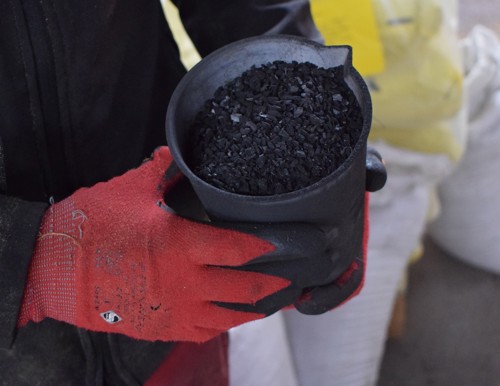
Although biochar has long been used in agriculture and horticulture its effect on these systems is still not fully understood.
Biochar is known to have benefits when used as a feed additive:
And some possible benefits:
The stable nature of biochar is not broken down by animal digestion and so it was felt that feeding biochar to cattle might be worth looking at with a view to effect on animal health, with a secondary benefit of the resultant manure being a charged biochar with additional soil health properties.
The trials took part in three phases:
An initial pilot phase: the farmer fed nine heifers one bag of biochar every morning for seven days.
The first two trials looked at the effect of biochar on four areas of interest:
The trial collected data on:
For the pot trial, 21 treatments were established (four replicates) taking the manure from both groups of cattle and adding extra substrates to it. The pots were each sown with Italian ryegrass. These were placed on benches outside and watered as necessary. The grass was cut three times and the dry weights determined.
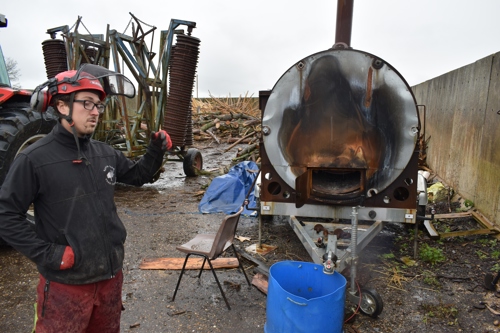
Overall, this study has demonstrated that adding biochar to the diet of cattle is an easy and manageable intervention that may have positive connotations for animal health and carbon storage, as well as potential nitrates management. For this reason then it is felt that further studies are required. This simple trial was not able to demonstrate the effect of biochar on cattle health or improvements in grass growth but, anecdotally there have been some interesting conclusions borne out by other studies. It may be that the reduced nitrate in the manure resulted from improved nitrogen assimilation in the gut and that overall animal health did improve along with live weight gain.
A full final report can be found in the reports section of the field lab page.
Phase two of this trial is currently under way, looking at the effect digested biochar has on rye grass growth through pot trials.

The final phase of this trial starts in mid July and will assess whether feeding biochar to cattle decreases worm burden in young stock. Using the same approach as phase one of the trial, a split herd with one group fed biochar and a second control group, the farmer will use a FECPAK kit to monitor the worm burden in the herd.
Initial analysis of nitrate and ammonia in the manure from the two teams of cattle, is now complete. Although the methodology was not sensitive enough to pick up any changes in ammonia emissions, findings show that the cows that were fed biochar excreted less nitrate in their manure than those that were not fed biochar. The reasons for this are not clear, and the researchers are currently working on future bids and projects to find out more about this process.
For a full report on the initial results, see the reports and results section of the field lab page
Phase 2 of this trial, with a larger sample size and longer feeding period, has started. Cattle from the herd have been split into two teams, the "Bio team" who will be fed 300g of biochar per day for 28 days; and the "Non Bio" team who will have no change to their diet. Manure samples will be collected from the two teams every other day throughout the trial, and will be analysed and compared in laboratories at the University of Coventry.
Manure samples were collected for the duration of the trial from both sections of the herd, and have been sent to the researcher who will carry out lab-based analysis looking at ammonia volatilisation, manure ammonium levels and dry weights. There had also been plans to compare worm burden using faecal egg counts during this trial, however this was not possible as the cattle did not have any worms. A worm burden assessment will be carried out later in the year when a base level of worm burden is identified in the herd, using the same split herd method with half fed biochar and half as the control.
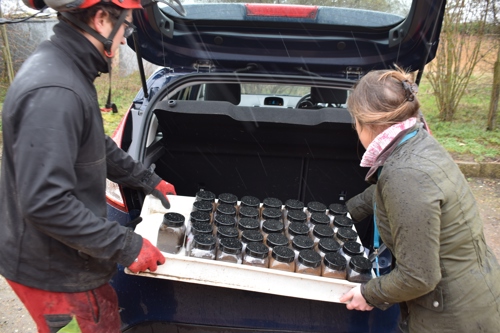
Pot trials growing rye grass will be used to determine the impact of digested biochar on plant growth, and will be underway shortly.
Results from the lab-based analysis will be presented at a meeting in September, details tbc.
The biochar project has been looking at the effect of feeding biochar on livestock, particularly on the effect on nitrate and ammonium in manure. Richard Copley, the farmer and biochar maker also described his system and his observations during the trial process. The biochar produced came from mixed species of timber cleared as part of his tree surgery business. He also supplies restaurants with charcoal and as a result, was very selective of what timber was used.
The biochar was ground to 5mm and fed with rolled barley and protein at 300g per head to 5 cattle, a second bunch of 5 were fed the same barley mix without biochar. These cattle were also fed silage as forage.
One question raised was about the potential for home grown biochar to be used. EU rules do require that only biochar made from natural and untreated wood is permissible. However, on a farm scale any virgin timber, off-cuts from carpentry and even brash from hedges and agroforestry could be used. Alternative feed stocks such as straw are possible but are not included in this project. Different species do produce different honeycomb effects in biochar. Further research would be needed.

The Exeter retort that Richard used produces about 150kg from a 450kg load of timber. This would feed 500 cattle for a day, or a 100 cow herd for 5 days. The 100 cow herd would need 11 tonnes of biochar, produced from approximately 33 tonnes of wood. If from short rotation coppice biomass, this would require from 3-5 ha of land per year. If on a 3 year rotation 10-15ha of land would need to be dedicated to this process. Alternative sources such as managed woodland, hedges and agroforestry systems can supplement the area. Straw, hemp and bracken are potential alternatives subject to regulations.
Yield of crop biochar will vary depending on tree species, cutting season and growth stage. However, unlike biomass heat systems, the carbon will be returned to the soil in a more stable
Manure samples have been taken every other day for a week from the selected cattle taking part in Phase 2 of the trial. This will establish a benchmark for natural ammonia emission levels prior to the experiment. Phase 2 of the trial will commence at the end of February and run for 28 days.
Aim
To establish a field lab to investigate the effects of ingested biochar on beef cattle along the following parameters;
1. Ammonia emission from manure
2. Ammonium retention in manure
3. Manure dry matter
4. Manure pH
5. Cattle worm burden
6. Effect of biochar/manure on grass growth and other soil parameters.
Design
The triallist will split some of his beef cattle herd into groups of 5. The so called “Bio Team” group will be fed 300g per day, for 28 days, of the farmers own biochar (feedstock deciduous tree trimmings, and biochar crushed and sieved to fit through a 4mm sieve). The “Non Bio” team will have no change to their diet.
Measurement of ammonia emission
In order to establish natural ammonia emission levels prior to the experiment, the farmer will collect 3 x 500g pots of manure from different cows in each team - 6 pots total. This will be done every other day for a week to establish ammonia levels of the herd (rather than each cow). On day 1 of the experiment, the Bio team will each receive 300g of biochar in their trough. Three manure sample pots will continue to be collected from each team every other day. The researcher will collect these pots to bring back to the lab where they will be analysed.
Analysis
Manure samples will be analysed using a FOSS Fiastar continuous flow analyser to show ammonia emission levels, as well as levels of ammonium retained in the manue. In total 126 samples will be analysed. Percentage dry matter will be calculated along with pH, and a FECPAKG2 will be used to assess worm burden.
During April, a pot trial will be established to evaluate the effect of biochar/manure on rye grass growth at 2 application rates with non and bio manure. Dry weight of grass and different soil parameters will be monitored once a month until September.
The initial results of this Phase 1 short-term trial have not been able to verify the effects of biochar on cattle health, however they have shown that cattle will consume the biochar incorporated feed .
The researcher is working with the triallists to develop and expand the methods for Phase 2 of the trial, which will take place over a longer duration.
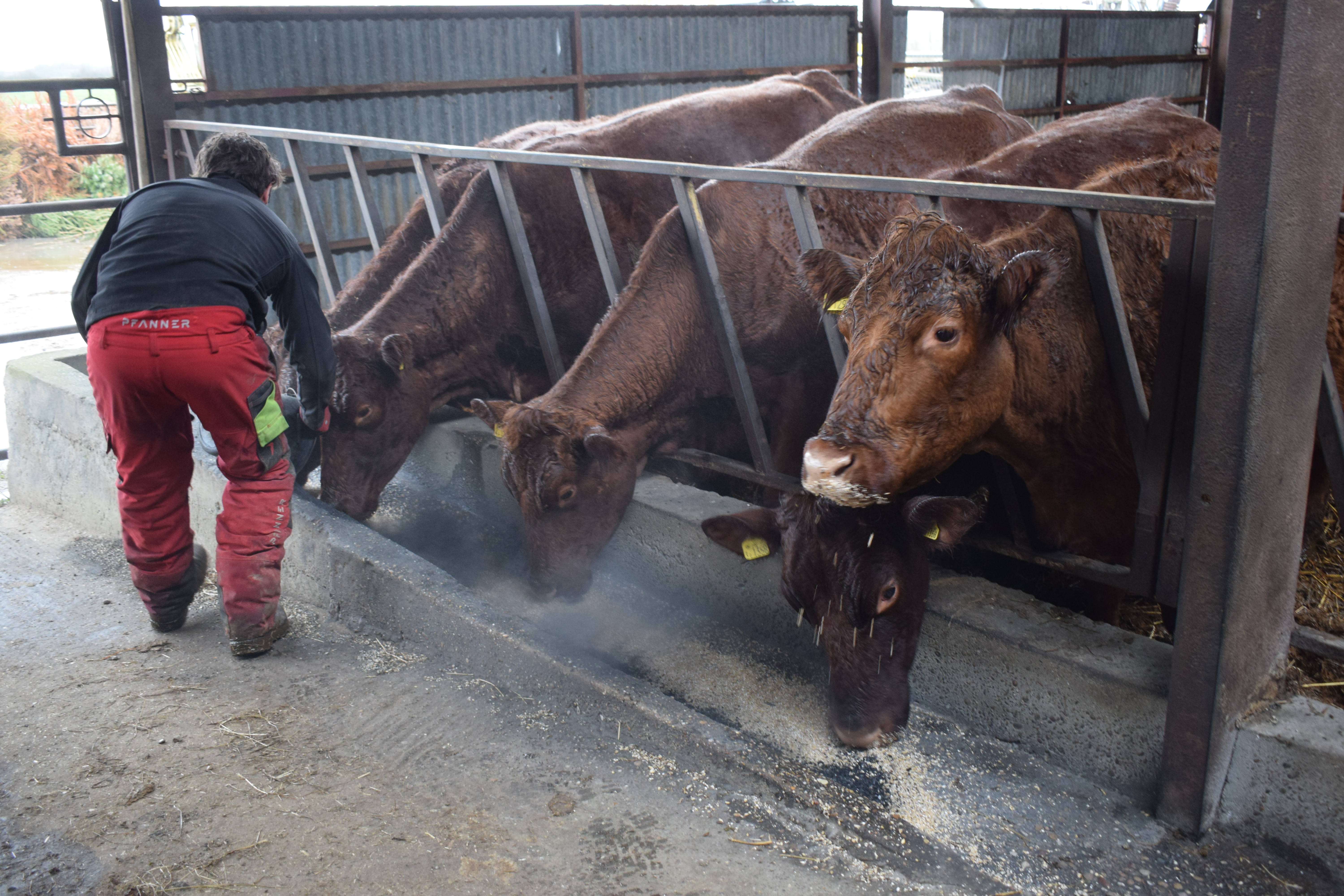
Feeding biochar to cows
Donna Udall of CAWR talked through the work that has been done at Coventry University on Biochar including a citizen science project on vegetable crops.
In the Citizen science trial, 80 vegetable growers were sent seeds and biochar which was applied at an equivalent of 2 kg/m2. The results showed a significant (p=0.026%) increase in cabbage yield but no significant increase in carrot or beetroot yield.
In soil incubation trials adding biochar and digestate showed an increase in total nitrogen mineralisation compared with no application, with different soils types responding differently. Biochar was not so effective on clay soils, implying perhaps that it slowed down the release of mineralised N.
A similar result came when comparing soil types in a pot trial with ryegrass yield, with sand showing a higher yield, and also less difference between a premix biochar and separate applications of biochar and digestate. Higher rates of Biochar also showed lower mineralisation.
In a field trial comparing biochar treatments along with digestate and fertilizer treatments the biochar showed slightly lower yields in both treatments. Although leaf chloroyphyll readings, which are a measure of nitrogen uptake, were lower during the early growth stages of the digestate treatment there was no final significant yield difference between the 4 treatments. The significance of this agriculturally is that Biochar could modify the availability of nitrogen, making nitrogen available to the plant longer during the year and reducing the potential for loss.
The evidence seems to be that biochar may slow mineralisation of nitrogen, but there is a soil type effect which may be due to soil microbial action, changes in cation exchange capacity and labile carbon availability.
Background - Biochar
Biochar is well known in horticulture as a soil additive, used to improve fertility, cation-exchange capacity and soil microbial activity. It can also help sequester carbon and reduce emissions of other greenhouse gases
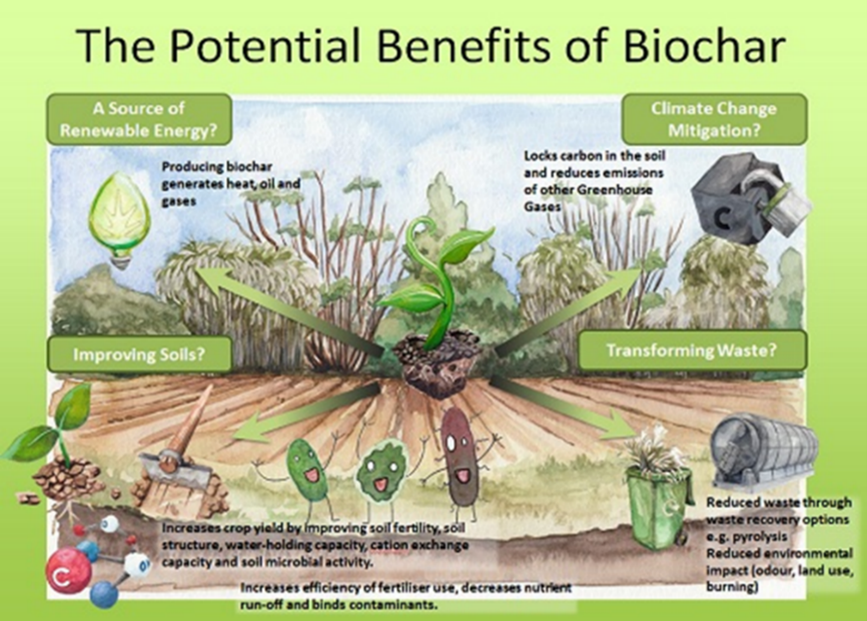
The potential benefits of biochar
Biochar is also known to have benefits when used as a feed additive, charcoal being used to reduce gas production from the rumen and being found to lead to increase milk yield and quality and a more stable manure, with some evidence of increased ammonium nitrogen and reduced nitrate and nitrite. There is also evidence that it can have benefits on parasites such as worms and coccidiosis (Gerlach and Schmidt, 2014). Biochar is also something that has been used over thousands of years to reduce toxins in the body, as it has a scavenging effect on them including dioxin, glyphosate, mycotoxins, pesticides and PAHs (polycyclic aromatic hydrocarbons), (Kana et al., 2010). The online magazine Progressive Dairy Canada recently published an article describing its use with two Canadian farmers who have been using it as a preventative within a healthy diet, both claim to have found benefits in healthier herds and lower vet bills, with one also saying that the herd’s manure has distinctly less odour (The Progressive Dairyman Canada, 2018). This may mean less methane emissions from cattle.
A reduction in the release of ammonia from manure will not only reduce odour issues for farmers but also contribute to a reduction of this greenhouse gas emission from agriculture. If this is the case, it is also hoped that less ammonia release will mean more ammonium in the manure, and less leaching from that manure, which should result in improved crop growth. The ability to reduce anthelmintic use, or reduce the effect of low level worm burdens, is also a possible beneficial outcome. Evidence of lower faecal worm eggs would also reduce the need for medical treatment, particularly of a prophylactic nature.
The group met again in March to discuss methods and costs for the trial ahead.
One triallist is already experimenting with biochar and added value to the practicalities of the methods discussed. The group are looking to put biochar on fields sown with corn and then combined in summer. The corn will be weighed against a control to check for differences. Other members of the group are planning to mix biochar with feed for cows for more short term trials. This is expanding on previous research, which may set some questions for the following year of trials.
Methods
This field lab will investigate these effects and measure the impact on both dairy and beef cattle, and the resultant manure. An initial trial has already looked at the effects on a small group of cows to see if there are any noticeable differences on ammonia production when feeding for a week. The farmer produced his own biochar from native hard and soft woods sourced from his tree surgery business. These woods were pyrolysed in his Exeter Retort, ground to less that 2 mm and bagged into 20 g bags.
From the 14th May 2018, the farmer fed 9 heifers 1 bag of biochar every morning for 7 mornings. Manure samples were collected on the 14th (prior to feeding) and every morning thereafter for 9 days, placed in a plastic bag, tied and labelled. It was not noted which cows’ samples were collected from. The researcher had collected all samples by day 10.
The samples were stored in a fridge (4℃) until analysis. Four methods of analysis were undertaken; dry weights, ammonia volatilisation and ammonium and nitrate content to establish if the addition of biochar to diet had any effect on these parameters.
Analysis
Dry weights: These were established for all samples by drying in an oven at (80oC) for 24 hours until weight stabilised.
Ammonia volatilisation analysis: 40 g of all samples (4 replicates) were placed in a 250 ml bottles with an acid trap placed in the screw top and sealed. The acid trap comprised of polyurethane foam pre-soaked in a solution of 10% phosphoric acid and glycerol. The acid traps captured any ammonia volatilised off the sample for a period of 24 hours and then 1 week. The foam acid traps where then removed and placed in 100 ml of 2 molar potassium chloride (KCl) solution and shaken for 1 hour. The extract was then filtered through Whatman. No.1 filter paper and analysed in a continuous flow analyser (FOSS Fiastar).
Ammonium content analysis: 20 g of all samples (4 replicates) were placed in 250 ml bottles along with 100ml of 2M KCL. This was then shaken for 1 hour and the extractant filtered through Whatman. No.1. This was then analysed for ammonium in the continuous flow analyser.
Nitrate content analysis: As above but analysed for nitrate in the continuous flow analyser.
Initial results and further trial methods
The results of this trial have given a good indication of the practicalities of the bigger trial. But it was considered that not enough time was given to allow the biochar to have any measurable effect on dry weights, ammonia content and ammonia volatilisation of the manure. It is thought that with a longer feeding / trial period an increasing amount and duration of biochar in the cows’ stomach it might act to adsorb ammonium and therefore limit ammonia production from cow pats. This has been suggested in previous research – see background document for full references.
This longer trial will look at ammonia volatilisation, manure ammonium levels, dry weights and worm burden (using Faecal egg counts).
There are 4 farms taking part which include both beef and dairy. The beef farmer will use a similar methodology to the initial trial, with samples taken from 4 cows twice a week. One dairy farm is able to split his herd on a permanent basis for the winter, and this would allow National Milk Records data to be analysed to see if there are any milk quality and animal health benefits from the use of biochar in the diets. The samples from the dairy herd will be bulked. The manures could then be used to assess the effect of biochar treatment in a controlled trial on grass growth in plot or pot or both. The same analysis will be carried out using the same laboratory methods as the previous one-week trial.
The full trials will begin when cattle have been housed in autumn 2018. Findings from the pilot trial indicated that trial will need to run for at least 56 days to allow for dietary changes to be taken into account.
Samples will be collected every 2 days (or as agreed with farmer). The researcher will then collect these samples and store, as appropriate, until able to perform lab-based analysis. Farmers will assess the cattle for worm burden, using a FECPAK, as agreed with farmer. In Spring 2019 lab-based analysis for ammonia volatilisation on stored samples will be performed
The group of seven farmers met with Soil Association Soils Advisor Jerry Alford and researcher Dr Francis Rayns to discuss current research on biochar and possibilities for field lab trials.
Dr Rayns gave an introduction to biochar including some of the historic and more recent uses of biochar. He related that biochar is complex and still undefined - with raw materials, heating temperature and duration, particle size and aging all being variable.
Different production systems using different kilns were also highlighted, although there is a Biochar Quality Mandate which is aimed to get some standards into the UK, as well as UK and worldwide Biochar associations and foundations. He finished with some trial results demonstrating some of the trials he and his colleague Donna Udall have done.
He then listed a range of areas where there are questions about biochar:
• These were comparisons of different biochar’s including the raw materials used (hard or soft wood waste wood etc.) heating temperature and duration during production.
• Effect of application rate and frequency
• Effects in combination with fertilizers
• Comparison on different soil types and cropping
• Long-term effects
Of the seven members in the group four are biochar producers all using the same kiln, but using different materials. All the farmers are looking at improving soil health using biochar either as a soil additive or via animals as an animal and soil health improver.
The group would like to understand the effects of biochar in relation to waste utilization, methane reduction, carbon sequestration, potential long-term soil health improvement and sustainability.
On direct use on the soil, one of the group was using biochar on arable crops as a trial with 2 rates on whole tramline widths. He was planning to use combine yields to assess any impact.
The conclusion of the discussion that there were four areas of interest that could be looked at and these were:
1- effect of biochar/charcoal on health and yield in a group of dairy cows
2-effect of manure from above cows on pot grown plants in a greenhouse
3- effect of Charcoal/Biochar on growth rate of a group of weaned cattle
4- effect on yield of arable crops of biochar.
Numbers 1.3 and 4 are simple field/barn scale projects with farmers in the group being able to monitor with existing data collection.
Number 2 would require specialist knowledge and is consistent with trials being run currently at Coventry University.
June 2018 - data collection
Septmber 2019
February 2019
September 2019
October 2019

Soil Association
Bristol / UK-wide
Arable & Soils Advisor at Soil Association, and farmer. I ran the family farm in Devon for 25 years, farming dairy, then organic beef, sheep and arable units with holiday cottage conversions. Former chairman of a local farmer owned co-op grain store, and involved in the grain supply chain nationally.

Coventry University - Centre for Agroecology, Water and Resilience
Coventry
In this section you will find reports and results from the field lab, as well as other relevant documents.